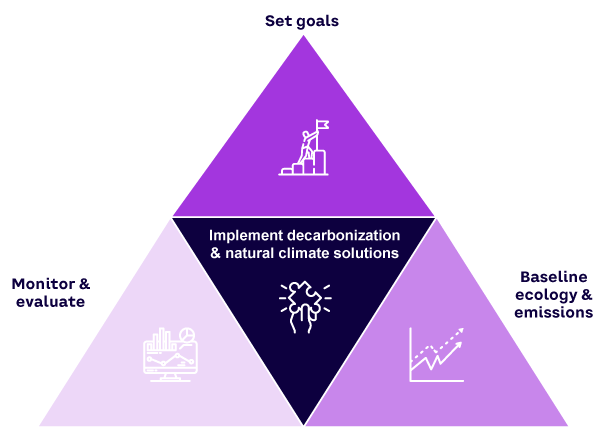How can every campus and peri-urban community drive its greenhouse gas (GHG) emissions sharply downward while managing open space to maximize biodiversity and carbon sequestration?
Duke Farms, a center of the Doris Duke Foundation in peri-urban New Jersey, USA, has developed a holistic operating framework to answer this urgent question. This framework is directly relevant and adaptable for landowners and managers worldwide, including corporate and university campuses and planned communities.
As atmospheric CO2 concentrations surpass 419 parts per million and national governments falter in their Paris climate commitments, putting Earth on track for more than 1.5°C of warming, Earth is entering its sixth mass extinction of species in 4 billion years — this time attributable entirely to human activity.
Local action at scale is required to mitigate the threats of extinction and increased warming. By virtue of their mixed land-use regimes (including interwoven developed areas, agriculture, preserves and open space, and other infrastructure), campuses and peri-urban communities in the transition zones between dense urban cores and rural areas are well-positioned to support a global transition to a nature positive and carbon negative future.1 Their strategic location near major transportation corridors, ability to engage diverse populations, and opportunity for innovation and demonstration amplify their potential for scalable impact. However, lack of knowledge, incentives, resources, and/or ability to balance trade-offs can be significant barriers to progress.
Ready or not, leaders across sectors (corporate, nongovernmental organizations, education, healthcare, planning and design, and government) are being pressured to act via:
-
Shareholder, employee, citizen, student, and customer demands
-
Regulations and transparency requirements
-
Resilience and recovery needs as climate and weather become unstable
-
Threats to supply chains and operational continuity
-
A sense of mission or moral obligation (in some cases)
The Duke Farms operating framework (see Figure 1) is built from four mutually reinforcing components:
-
Setting goals
-
Baselining ecology and emissions
-
Implementing solutions:
-
Prioritizing decarbonization solutions
-
Seeking natural climate solutions
-
Identifying and managing trade-offs
-
We depict this framework as a pyramid built from interlocking components. Although the framework could be followed in a clockwise manner, our experience shows us that, ideally, each component influences the other in real time for a true adaptive management approach.

Note
1Here, we define “campus” as a parcel of land containing both buildings and open space used for one or more human purposes.
[For more on efforts at Duke Farms, see: “Nature Positive, Carbon Negative: Reimagining the Role of Campuses & Peri-Urban Communities.”]





